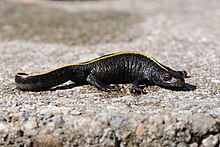Triturus carnifex
| Italian crested newt | |
|---|---|
 |
|
| Juvenile with yellow dorsal stripe | |
| Scientific classification | |
| Kingdom: | Animalia |
| Phylum: | Chordata |
| Class: | Amphibia |
| Order: | Caudata |
| Family: | Salamandridae |
| Genus: | Triturus |
| Species: | T. carnifex |
| Binomial name | |
|
Triturus carnifex (Laurenti, 1768) |
|
 |
|
| Range of T. carnifex in Europe | |
The Italian crested newt (Triturus carnifex) is a species of newt in the family Salamandridae.
Triturus carnifex is found in parts of the Balkans and Italy. It is an aquatic breeder that can spend up to four months in the water. The location of the ponds where they breed affects the time when T. carnifex enters the water.T. carnifex prefers living in deep water since it is a nektonic species: it swims freely and is independent of currents. The absence of predatory fish may also explain why T. carnifex is inclined to ponds, rather than other larger bodies of water.
They typically prefer ponds in northern Europe, where temperatures are colder. Adult T. carnifex start to arrive between February and May, and leave between July and October. In warmer ponds, adult newts arrive within a month and leave during a two-week period in July. Andreone and Giacoma (1989) speculated that newt migration into the ponds increases after rainy days, since after rainfall, newt activity is not limited by humidity.
Higher altitudes, where temperatures begin to decrease, have a direct effect on the size of T. carnifex. Ficetola et al. (2010) discovered that living in colder temperatures resulted a body size increase in both male and female. Females in higher altitudes were found to be larger because they were carrying more oocytes and larger ovaries, which gave them a reproductive advantage over the smaller females.T. carnifex is poikilothermic and larger body sizes help to reduce heat fluctuations. Ficetola also found that fluctuations in body temperature of T. carnifex decreased when body size increased. An increase in body size also occurs where there is increased precipitation or nearby primary producers, due to the effect of increased resources on animals.
Human interference has dramatically changed the habitat of T. carnifex due to the expansion of industrial areas and urban centers. This results in a fragmentation of natural landscapes, which leads to selective extinction, genetic drift, and inbreeding from isolation. Introducing fish to isolated wetland habitats also leads to a decline of amphibians because of predation on newt larvae.
T. carnifex is a pond-dwelling species of salamander that has adapted to living in temporary or polluted ponds. As a result, adult newts in the genus Triturus have multiple ways to respire. The three methods of oxygen intake are via the skin (the primary source), lungs, and buccal cavity. This is due to their poorly vasculated, elastic, simple lung structures, although the lungs are more vasculated at the posterior end. This is important when there are poor oxygen conditions, as it causes the newts to use pulmonary respiration as their primary source. In addition, newts also use pulmonary respiration in active metabolic states such as courtship, breeding, or food gathering, when they ventilate at 3-minute intervals.
...
Wikipedia

